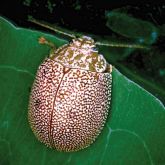Leaf beetles

Eucalyptus tortoise beetle (Paropsis atomaria) adult
© Queensland Government

Mature larvae of the Eucalyptus tortoise beetle (Paropsis atomaria) feeding on eucalypt leaf
© NSW Government

Eucalyptus leaf beetle (Paropsisterna cloelia) adults
© FWPA

Larvae of the Eucalyptus leaf beetle (Paropsisterna cloelia)
© Queensland Government

Damage to mature leaves by chrysomelid adults–note the scalloped edges
© NSW Government

Adult flea beetle (Chaetocnema species) on petrie dish
© Queensland Government

Flea beetle (Chaetocnema species) damage to the upper surface of a Dunn's white gum (Eucalyptus dunnii) leaf
© Queensland Government
Leaf beetles (Chrysomelid leaf beetles) include eucalyptus tortoise beetles (Paropsis species), eucalyptus leaf beetles (Paropsisterna species) and flea beetles (Chaetocnema species).
Larvae and adults feeding on leaves can defoliate trees and repeated defoliation can negatively impact tree growth.
Scientific name
Description
Eucalyptus tortoise beetle (Paropsis atomaria)
- Adult leaf beetles may look like ladybird beetles, but with longer antennae; distinguishing between the two is important because ladybirds are beneficial insects.
- They are up to 10mm long, dome-shaped, and speckled, with metallic pink, yellow, beige or red colours.
- Adults may have finely patterned elytra (wing covers); some of these are strongly patterned with red and black.
- Immature larvae are 2–3mm long and yellow-green; mature larvae have black stripes on the abdomen.
- See additional images.
Eucalyptus leaf beetle (Paropsisterna cloelia)
- Adults are less than 10mm long and dome-shaped.
- They are mostly orange but can be dark brown or black with an orange edge and head.
- Larvae are 2–12mm long and yellow-green to olive-green with dark heads; mature larvae have thin black stripes on the abdomen.
- See additional images.
Flea beetles (Chaetocnema species)
- Adults are 1.5–3mm long, black, shiny and metallic.
- They have puncture marks on their electra (wing covers).
- Enlarged hind legs enable them to jump, hence their common name.
- It is difficult to find individuals on foliage, but they may be identified by their damage.
- They beetles commonly feed in groups and jump when threatened.
- See additional images.
Distribution
Eucalyptus tortoise beetle (Paropsis atomaria)
- Common and widely distributed throughout south-eastern Queensland and south-eastern Australia.
Eucalyptus leaf beetle (Paropsisterna cloelia)
- Found in south-eastern and northern Queensland.
Flea beetles (Chaetocnema species)
- Found throughout Queensland, from tropical to temperate zones, in coastal and inland areas.
Hosts
Eucalyptus tortoise beetle (Paropsis atomaria)
- Gympie messmate (Eucalyptus cloeziana)
- Dunn's white gum (E. dunnii)
- Rose gum (E. grandis)
- Blackbutt (E. pilularis)
- Sydney blue gum (E. saligna)
- Forest red gum (E. tereticornis)
- spotted gum (Corymbia citriodora and C. maculata).
Eucalyptus leaf beetle (Paropsisterna cloelia)
- Dunn's white gum (E. dunni)
- rose gum and hybrids (E. grandis)
- large-fruited red mahogany (E. pellita)
- blackbutt (E. pilularis)
- swamp mahogany (E. robusta)
- forest red gum (E. tereticornis).
Flea beetles (Chaetocnema species)
- Large host range, particularly shrubs and herbaceous plants.
- Many acacias, rainforest plants and eucalypts, including:
- western white gum (E. argophloia)
- Dunn's white gum (E. dunnii).
Damage
Eucalyptus tortoise beetle (Paropsis atomaria) and eucalyptus leaf beetle (Paropsisterna cloelia)
- These beetles usually affect trees less than 3 years old.
- Defoliation is by clusters of feeding larvae, particularly in the soft young growth in the crowns.
- High densities of larvae consume the entire leaf and can stop the central tree stem growing more strongly than side stems (apical dominance). Trees typically develop a 'broom top' appearance.
- Adults feed on mature leaves, leaving characteristic scalloped leaf edges.
- There are often 2 defoliation events per year: in late December to early January, and late March to May. However, in south-eastern Queensland and northern New South Wales, up to 4 generations a year can cause at least 3 peaks in defoliation.
- Repeated, widespread defoliation affects growth and form.
Flea beetles (Chaetocnema species)
- Feeding adults etch the upper surface of the leaf, causing necrotic patches to form.
- Leaves may look as if blasted by a shotgun.
- Damage is most evident in winter.
- Impacts are usually restricted to the lower third of the canopy.
- Loss of growth is not usually significant.
Biology
- Eggs are laid on eucalypt leaves and stems, or in the soil (flea beetles).
- Larvae feed on leaves in a group.
- When mature, they drop to the ground to pupate in the soil.
- There can be up to 4 generations per year.
Control
- Natural predators include shield bugs, ladybirds, wasps, spiders and tachinid flies.
- For ornamentals or small numbers of young trees, adults and larvae can be collected into soapy water. Eggs can be scraped off shoots and larvae hosed off foliage.
Resources and research
- Carnegie, A, Lawson, SA, Smith, T, Pegg, GS, Stone, C, McDonald, J, 2008, Healthy hardwoods: a field guide to pests, diseases and nutritional disorders in subtropical hardwoods, Forest and Wood Products Australia, Victoria.
- Jones, DL, Elliot, WR, Jones, SR, 2015, Pests, diseases, ailments and allies of Australian plants, Reed New Holland Publishers Pty Ltd, Chatswood, NSW.
- Nahrung, HF, Duffy, MP, Lawson, SA, Clarke, AR, 2008, Natural enemies of Paropsis Atomaria Olivier (Coleoptera: Chrysomelidae) in south-eastern Queensland eucalypt plantations, Austral Entomology, 47(3):188–194, viewed July 2023.
- Pests and diseases image library (PaDIL)
- Australian Pesticides and Veterinary Medicines Authority (APVMA)